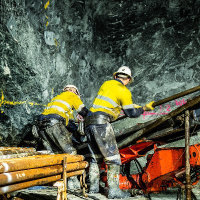
Red 5 Ltd
ASX:RED

Red 5 Ltd
Buried deep in the landscape of Western Australia's mineral-rich terrain lies Red 5 Ltd, a company that has not only unearthed substantial gold deposits but also carved a niche for itself in the volatile gold mining industry. Since its inception, Red 5 has focused on exploring and developing gold mines that shine with promise and potential. The core of its operations lies in the Darlot and King of the Hills mines, which are both rich in history and gold-filled veins. By leveraging modern mining techniques and optimizing production processes, Red 5 maximizes its gold extraction capabilities. This approach enables it to extract gold efficiently and at a competitive cost, positioning itself as a formidable player in the Australian mining sector.
To translate its robust mining operations into a sustainable business model, Red 5 employs a strategy focused on scale and efficiency. After the raw gold ore is extracted, it is meticulously processed and refined to reach market-ready standards. Selling this gold in local and international markets brings the company substantial revenue, bolstered by its strategic hedging practices that mitigate the risks associated with fluctuating gold prices. The economic dynamics of the gold market play a crucial role in Red 5's financial health, influencing both its short-term profitability and long-term strategic planning. Through prudent management and a relentless focus on operational excellence, Red 5 earns its income by transforming the raw splendor of the earth into one of the most coveted commodities in the world, gold.
















































 You don't have any saved screeners yet
You don't have any saved screeners yet
